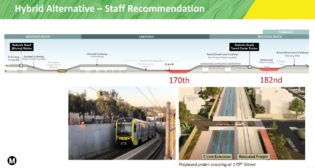
Ontario LRT facing hurdles
Written by John Thompson, Canadian Contributing EditorTwo of Ontario, Canada’s numerous light rail transit projects—the Kitchener-Waterloo ION and Hamilton Street Railway B Line—have been facing difficulties, albeit of a different nature. The former is still without functional LRVs; the latter is looking at potentially conflicting operating proposals.
ION LRVs, Extension Stalled
As of Sept. 5, there was still no word on arrival of a second Flexity LRV from Bombardier, which was supposed to occur in either August or September, and be more or less ready to operate. A Waterloo Region Councillor who is the point person on the LRT project said the agency is “in discussions” with Bombardier. The prototype LRV arrived on the property in February, but it still isn’t operational, despite the efforts of Bombardier engineers.
The first segment of the ION LRT is essentially complete, except for a few minor details, but won’t be operational until 2018 due to late LRV delivery from Bombardier. However, construction of a planned extension to the adjoining city of Cambridge may not commence until 2025.
Work on the Cambridge extension was originally hoped to begin soon after opening of the initial Kitchener-Waterloo line. However, the route proposed by the Waterloo Region Council (the overall governing body for both Kitchener-Waterloo and Cambridge) was rejected by the Cambridge Council in July 2017.
The reasons given for the rejection were essentially twofold: the LRT’s negative impact on motor vehicle traffic at Shantz Hill, a notorious bottleneck in north Cambridge; and the bypassing of the business district in the Preston area. Preston is one of three former towns (the others being Hespeler and Galt) that were amalgamated to form the city of Cambridge in the early 1970s. Population growth has not been as great here as in Kitchener-Waterloo, which has two universities and thriving downtowns.
Waterloo Region Council had devised a route that would leave downtown Preston at the edge of the business-residential district and take, in effect, a massive dogleg to the north—a route with minimal potential patronage—along Eagle Street and Hespeler Road. It would also miss a major local hospital, and a large industrial park.
This route was reportedly endorsed due to the hope for major future redevelopment along Hespeler Road, a thoroughfare characterized by almost exclusively automobile-oriented businesses (shopping malls, fast food restaurants, car dealerships, etc.). If the line were to continue straight through downtown Preston on King Street, which is four lanes wide, it would be necessary to remove curb parking to allow for a center reservation for the LRT tracks. This, of course, would likely be unpopular with local merchants and motorists. The alternative, a tunnel, would be very costly; however the Eagle-Hespeler plan would require several underpasses beneath railway lines.
Another factor is overall project cost: The Kitchener-Waterloo line was financed with a combination of federal, provincial and local funding, but it is questionable to what degree, if any, Cambridge taxpayers would be willing to contribute.
It thus appears that the Waterloo Region Council will have to return to the drawing board to come up with a proposal that will be accepted by Cambridge councillors and taxpayers.
Who Will Run Hamilton?
In a surprise, eleventh-hour action, the Hamilton Council recently approved, although not unanimously, a motion by Councillor Matthew Greene that the local bus transit provider, Hamilton Street Railway (HSR), have responsibility for operation and maintenance of the city’s LRT line. Construction is scheduled to begin in 2019, with opening in 2024 or 2025.
The project, although originated by the city, has been planned by Metrolinx, the provincial transit agency, using the design-finance-build-operate method. In short, Metrolinx would be responsible for most of the costs associated with the LRT’s construction and operation.
The rationale put forward by Councillor Greene, and the local branch of the Amalgamated Transit Union, was avoiding the possible loss of HSR jobs when the LRT opens, replacing parallel bus routes. One of these, the “B” line, is HSR’s heaviest, and thus produces the greatest revenue for the city-owned agency.
The ultimate decision is with Metrolinx, although Ontario Premier Kathleen Wynne, who is facing re-election, said in an interview that, in effect, she would consider the proposal.
Members of Hamilton’s City Council are also facing the voters in 2018.
Paul Johnson, of the City of Hamilton’s LRT office, and Andrew Hope, the Metrolinx manager associated with the project, both pointed out that, if approved, the Greene-ATU proposal could delay the start date by several months, as contract proposals would have to be rewritten and re-submitted to potential bidders.
In addition, if the HSR assumes responsibility for operations and maintenance, rather than Metrolinx, the city might have to cover the significant costs involved.
The LRT has been quite controversial with Hamilton residents, and has been partly sold to them on the basis that it would essentially be a “no cost” project for the city. In fact, the city would benefit from having utilities, road pavement and a major bridge replaced at Metrolinx expense.
It remains to be seen how the situation will be resolved, but presumably this will occur fairly quickly, perhaps with some form of compromise.
HSR, incidentally, is possibly the only North American transit operator to have never changed its name, dating back to horsecars in the mid-1870s. HSR electric streetcars made their last runs in 1951, but Hamiltonians have insisted on keeping the name, despite its inaccuracy. Now, of course, HSR should be returning to street railway operation.



